Escalator Foundation Bolt Loosening Fault Recognition Based on Empirical Wavelet Transform and Multi-Scale Gray-Gradient Co-Occurrence Matrix
Abstract
1. Introduction
2. Theories of EWT and BI-LSTM
2.1. EWT and Spectrum Division
2.1.1. EWT
2.1.2. Spectrum Division Improvement in EWT
- (i)
- Detect all local maximum points of s, form a set , and make the first update to the discriminant criterion , so that: .
- (ii)
- Use window functions with different widths to smooth the signal and obtain the corresponding smoothing results :where ∗ denotes the convolution operation, and denotes the standardized Gaussian window function. denotes the width of the window function, and denotes the length of the vibration signal.
- (iii)
- After each smoothing, the local maximum is redetected to obtain a new set . Combine the new set of local maximum with the initial set of local maximum, and increase the value of the corresponding position in the discrimination criteria :
- (iv)
- After scale iterations, the position of the spectral “peak” can be determined by . For a given number of peak detections, the first points with the highest values are taken in .
2.2. BI-LSTM
2.2.1. LSTM
2.2.2. BI-LSTM
3. Multi-Scale Fault Feature Extraction Based on GGCM
3.1. Bispectrum Analysis Theory
- (1)
- The vibration signal to be analyzed is divided into segments, with each segment containing samples. So, the signal after segmentation is:
- (2)
- For the th segment of data , calculate its discrete Fourier transform.
- (3)
- Calculate the third-order autocorrelation coefficients of DFT.where , , and denotes the sampling frequency.
- (4)
- Calculate the bispectrum estimation of the vibration signal.where and .
3.2. Bispectrum Analysis of EWT for Escalator Foundation Vibration Signal
3.3. Fault Feature Extraction Based on Gray-Gradient Co-Occurrence Matrix




3.3.1. Normalization of Gray Matrix and Gradient Matrix
3.3.2. Generation of GGCM
3.3.3. Texture Feature Extraction with Gray-Gradient Co-Occurrence Matrix
- Small-gradient dominance:
- 2.
- Inhomogeneity of the grey distribution:
- 3.
- Inhomogeneity of the gradient distribution:
- 4.
- Grey entropy:
- 5.
- Gradient entropy:
- 6.
- Mixed entropy:
4. Bolt Loosening Fault Diagnosis Model Based on EWT and GGCM

5. Analysis of Experimental Results
5.1. Collection of Experimental Data and Evaluation Index
5.1.1. Experimental Data
5.1.2. Evaluation Index
5.2. Comparative Analysis of Different Fault Feature Extraction Methods
5.3. Comparative with Machine Learning Algorithms
6. Conclusions
- (1)
- The Teager energy operator is used to concentrate spectral energy on the spectrum, which greatly reduces the erroneous influence of noise and irrelevant components on spectrum segmentation. The multi-scale “peak” localization method based on the Teager energy operator can detect the segmentation boundary of EWT adaptively, avoid the wrong decision caused by a single “pseudo-value point”, and make the spectrum segmentation more appropriate.
- (2)
- The feature extraction method based on the multi-scale GGCM does not require too many parameter settings, and the feature vector extracted from the multi-scale GGCM can effectively diagnose the loose footing fault. This method is simple, intuitive, and accurate and overcomes the difficulties of fault feature extraction using the traditional method.
- (3)
- The fault recognition method by jointing multi-scale GGCM feature extraction and the BiLSTM classifier has a high recognition accuracy and certain degree of universality, which can be used to identify and warn of foundation bolts loosening faults during the operation of escalators.
Author Contributions
Funding
Institutional Review Board Statement
Informed Consent Statement
Data Availability Statement
Conflicts of Interest
References
- Liu, L.-H.; Long, W.-P. Study on the cause and prevention of subway escalator passenger injury accident. Chin. Railw. 2011, 5, 2725–2746. [Google Scholar]
- Bonnardot, F.; Lizoul, K.; Errafik, S.; Ander, H.; Guillet, F. High frequency demodulation technique for instantaneous angular speed estimation. Mech. Syst. Signal Process. 2021, 152, 10720745. [Google Scholar] [CrossRef]
- Wang, W.-X.; Yang, Z.-L.; Hua, X.-G.; Chen, Z.-G.; Wang, X.-Y.; Song, G.-B. Evaluation of a pendulum pounding tuned mass damper for seismic control of structures. Eng. Struct. 2021, 228, 111554. [Google Scholar] [CrossRef]
- Meng, Q.-Y. Research on fault diagnosis method for main drive shaft bearing of escalator based EEMD-SVM. Mach. Electron. 2020, 38, 51–53. [Google Scholar]
- Ma, H.-X.; Li, Z.-X.; Wang, Z.-D.; Feng, R.-J.; Li, G.; Xu, J.-Y. Research on measuring device and quantifiable risk assessment method based on FMEA of escalator brake. Adv. Mech. Eng. 2021, 13, 1–17. [Google Scholar] [CrossRef]
- Karimpour, A.; Rahmatalla, S. Extended Empical Wavelet Transformation: Application to structural updating. J. Sound Vib. 2021, 500, 116026. [Google Scholar] [CrossRef]
- Sharma, V.; Raghuwanshi, N.K.; Jain, A.K. Sensitive Sub-band Selection Criteria for Empirical Wavelet Transform to Detect Bearing Fault Based on Vibration Signals. J. Vib. Eng. Technol. 2021, 9, 1603–1617. [Google Scholar] [CrossRef]
- Chui, K.T.; Gupta, B.B.; Liu, R.-W.; Vasant, P. Handling Data Heterogeneity in Electricity Load Disaggregation via Optimized Complete Ensemble Empirical Mode Decomposition and Wavelet Packet Transform. Sensors 2021, 21, 3133. [Google Scholar] [CrossRef]
- Li, J.-T.; Guo, J.; Zhu, X.-Q. Time-Varying Parameter Identification of Bridges Subject to Moving Vehicles Using Ridge Extraction Based on Empirical Wavelet Transform. Int. J. Struct. Stab. Dyn. 2021, 21, 215–226. [Google Scholar] [CrossRef]
- Sun, Y.-J.; Li, S.-H.; Wang, Y.-L.; Wang, X.-H. Fault diagnosis of rolling bearing based on empirical mode decomposition and improved manhattan distance in symmetrized dot pattern image. Mech. Syst. Signal Process. 2021, 159, 107–117. [Google Scholar] [CrossRef]
- Wang, S.; Niu, P.-J.; Guo, Q.-H.; Wang, X.-C.; Wang, F.-Z. An adaptive empirical mode decomposition and stochastic resonance system in high efficient detection of terahertz radar signal. Ferroelectrics 2020, 563, 148–160. [Google Scholar] [CrossRef]
- Antelis, J.M.; Rivera, C.A.; Galvis, E.; Ruiz-Olaya, A.F. Detection of SSVEP based on empirical mode decomposition and power spectrum peaks analysis. Biocybern. Biomed. Eng. 2020, 40, 1010–1021. [Google Scholar] [CrossRef]
- Lu, T.; Yu, F.-Q.-H.; Wang, J.-R. Application of adaptive complementary ensemble local mean decomposition in underwater acoustic signal processin. Appl. Acoust. 2021, 178, 107966. [Google Scholar] [CrossRef]
- Du, W.; Fang, L.-Q. Fault diagnosis of automaton based on local characteristic-scale decomposition and individual feature selection. IOP Conf. Ser. Earth Environ. Sci. 2017, 69, 012076. [Google Scholar] [CrossRef]
- Toma, R.N.; Kim, C.H.; Kim, J.M. Bearing Fault Classification Using Ensemble Empirical Mode Decomposition and Convolutional Neural Network. Electronics 2020, 107, 4077–4095. [Google Scholar]
- Wang, H.-L.; Wu, F.; Zhang, L. Applicationof variational mode decomposition optimized with improved whale optimization algorithm in bearing failure diagnosis. Alex. Eng. J. 2021, 60, 4689–4699. [Google Scholar] [CrossRef]
- Chouksey, M.; Jha, R.K. A multiverse optimization based colour image segmentation using variational mode decomposition. Expert Syst. Appl. 2021, 171, 114587. [Google Scholar] [CrossRef]
- Yan, X.-Y.; Liu, Y.; Zhang, W.; Jia, M.-P.; Wang, X.-B. Research on a NovelImproved Adaptive Variational Mode Decomposition Method in Rotor Fault Diagnosis. Appl. Sci. 2020, 10, 1696. [Google Scholar] [CrossRef]
- Li, H.; Lin, J.; Liu, N.-H.; Li, F.-Y.; Gao, J.-H. Seismic Reservoir Delineation via Hankel Transform Based Enhanced Empirical Wavelet Transform. IEEE Geosci. Remote Sens. Lett. 2020, 17, 1411–1414. [Google Scholar] [CrossRef]
- Ding, J.-M. A double impulsiveness measurement indices-bilaterally driven empirical wavelet transform and its application to wheelset-bearing-system compound fault detection. Measurement 2021, 175, 109135. [Google Scholar] [CrossRef]
- Zhang, K.; Ma, C.-Y.; Xu, Y.-G.; Chen, P.; Du, J.-X. Feature extraction method based on adaptive and concise empirical wavelet transform and its applications in bearing fault diagnosis. Measurement 2021, 172, 108976. [Google Scholar] [CrossRef]
- He, J.-J.; Song, C.; Luo, Q.-W.; Yang, C.-H.; Gui, W.-H. WT-ASG: Empirical Wavelet Transform With Adaptive Savitzky-Golay Filtering for TDLAS. IEEE Photonics J. 2020, 12, 3. [Google Scholar] [CrossRef]
- Mitiche, I.; Jenkins, M.D.; Boreham, P.; Nesbitt, A.; Morison, G. An expert system for EMI data classification based on complex Bispectrum representation and deep learning methods. Expert Syst. Appl. 2021, 171, 114568. [Google Scholar] [CrossRef]
- Liu, H.; Wang, Z.-B.; Zheng, B. Surface crack characterization using laser nonlinear ultrasonics based on the bispectrum. Meas. Sci. Technol. 2021, 32, 035204. [Google Scholar] [CrossRef]
- Wang, H.-B.; Long, J.-B.; Liu, Z.-L.; You, F. Fault Characteristic Extraction by Fractional Lower-Order Bispectrum Methods. Math. Probl. Eng. 2020, 2020, 8823389. [Google Scholar] [CrossRef]
- Xu, Y.-D.; Fu, C.; Hu, N.; Huang, B.S.; Gu, F.S.; Ball, A.D. A phase linearisation-based modulation signal bispectrum for analysing cyclostationary bearing signals. Struct. Health Monit. Int. J. 2021, 20, 1231–1246. [Google Scholar]
- Lee, J.-S.; Yoo, J.-H.; Baek, J.-H.; Park, S.-H.; Cho, S.-H. Advanced Phase-Difference Estimation Algorithm Using Cross Teager–Kai ser Energy Operator for DERs Synchronization. J. Electr. Eng. Technol. 2023, 18, 2517–2526. [Google Scholar]
- Chen, Y.J.; Wu, Z.N.; Zhao, B.; Fan, C.; Shi, S. Weed and Corn Seedling Detection in Field Based on Multi Feature Fusion and Support Vector Machine. Sensors 2021, 21, 212. [Google Scholar]
- Suthar, V.; Vakharia, V.; Patel, V.K.; Shah, M. Detection of Compound Faults in Ball Bearings Using Multiscale-SinGAN, Heat Transfer Search Optimization, and Extreme Learning Machine. Machines 2023, 11, 29. [Google Scholar] [CrossRef]
- Wang, J.; Zhan, C.; Yu, D.; Zhao, Q.; Xie, Z. Rolling bearing fault diagnosis method based on SSAE and softmax classifier with improved K-fold cross-validation. Meas. Sci. Technol. 2022, 33, 105110. [Google Scholar] [CrossRef]
- Talebitooti, R.; Gohari, H.; Zarastvand, M. Multi objective optimization of sound transmission across laminated composite cylindrical shell lined with porous core investigating Non-dominated Sorting Genetic Algorithm. Aerosp. Sci. Technol. 2017, 69, 269–280. [Google Scholar] [CrossRef]
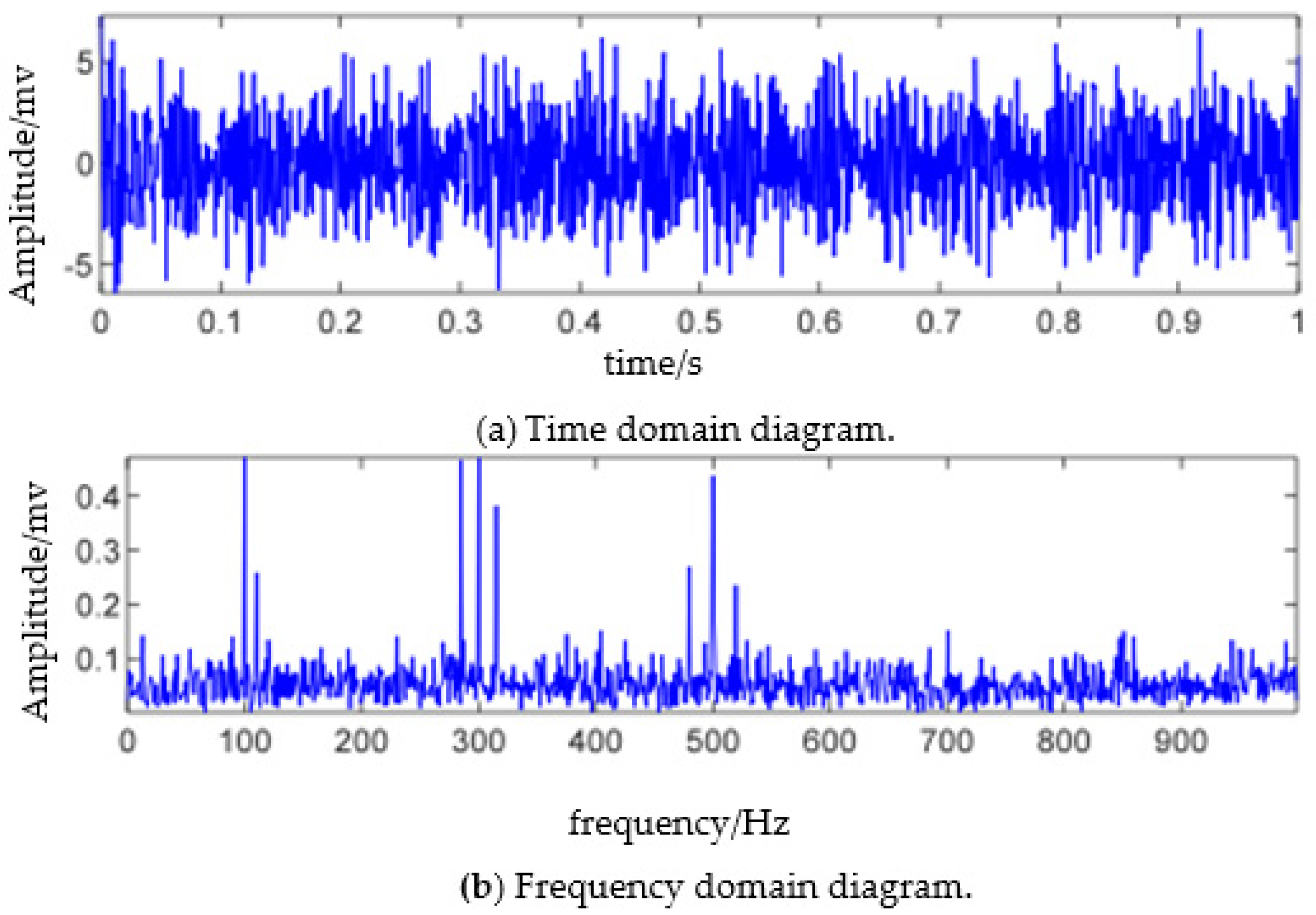
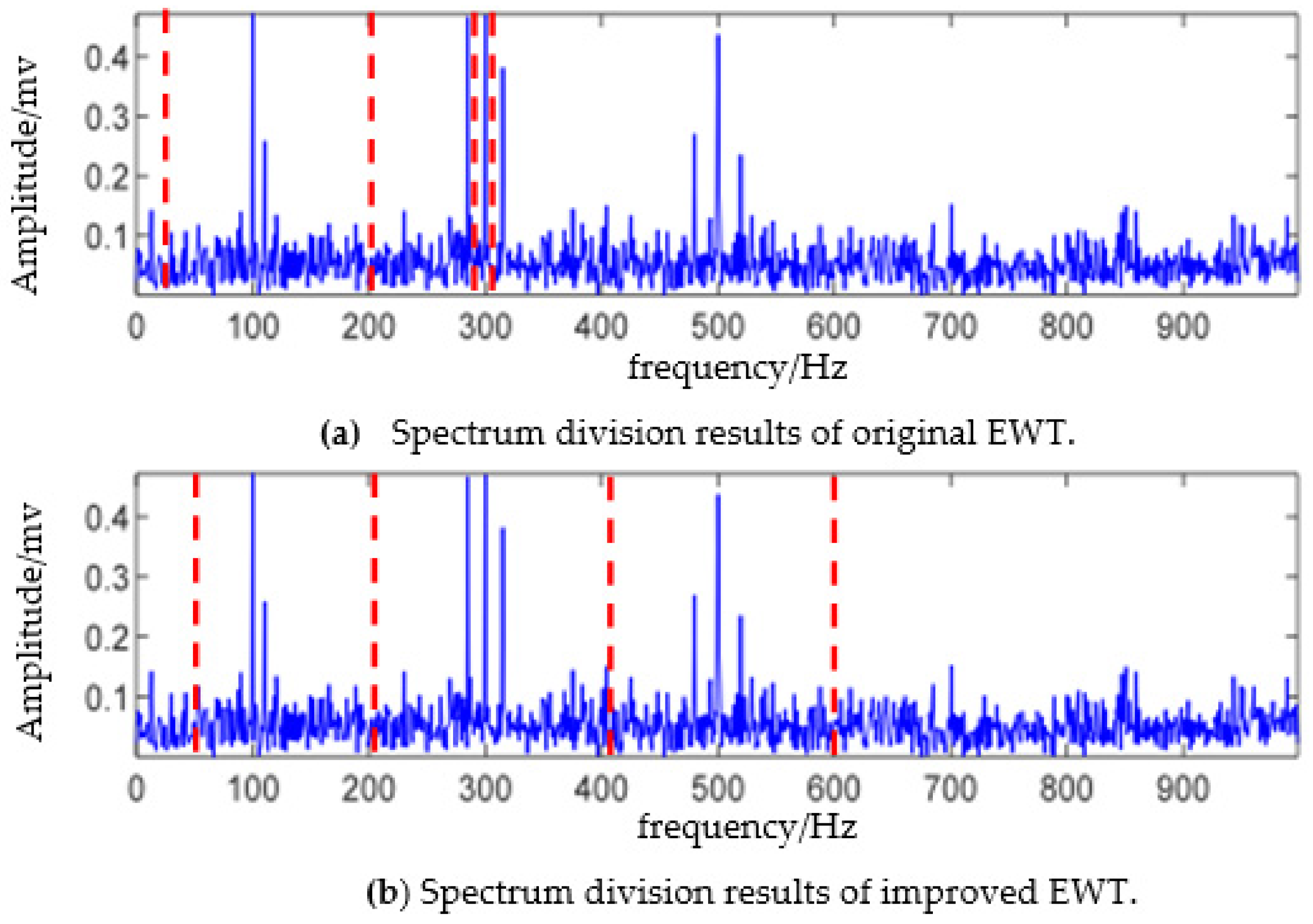


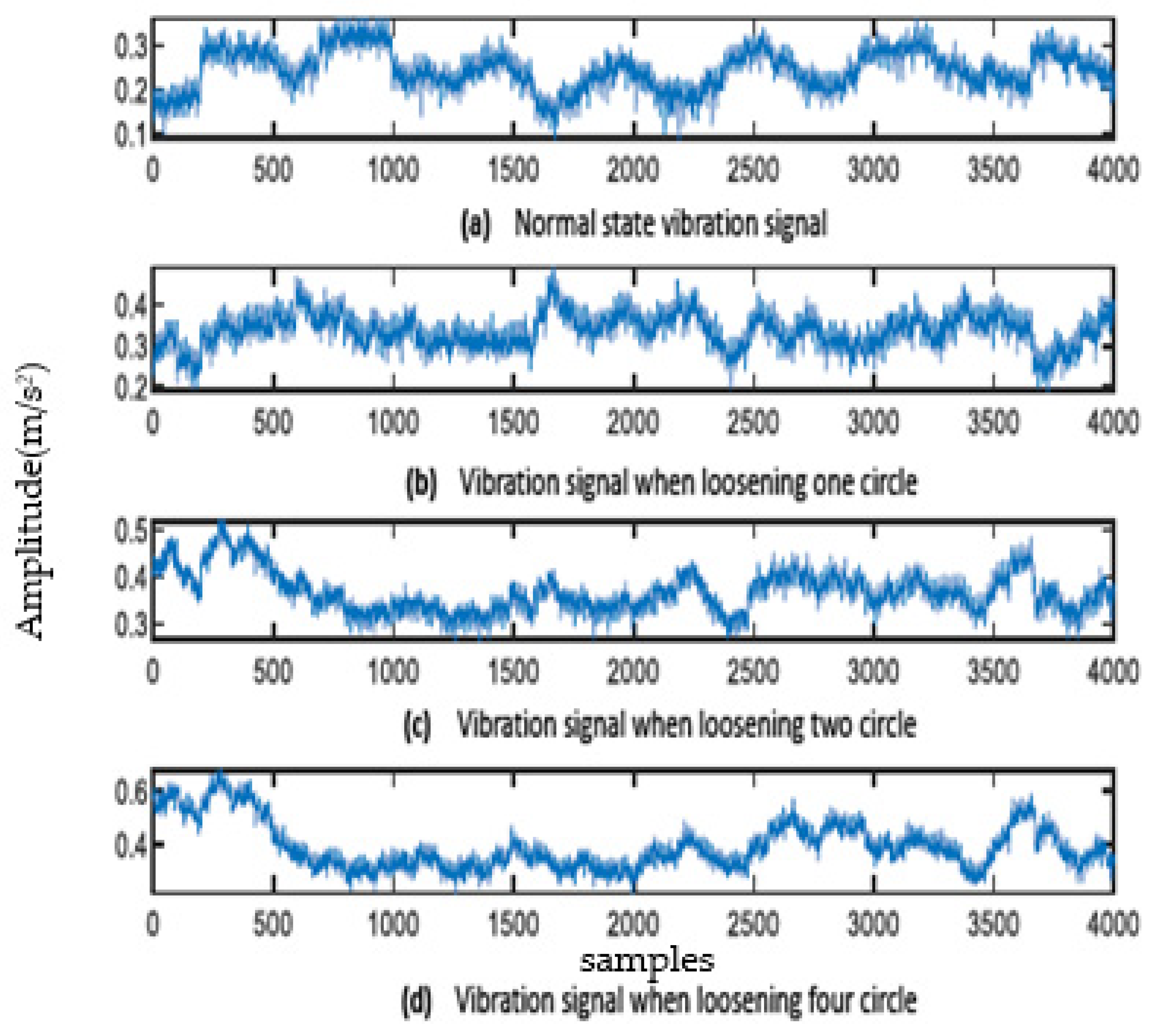
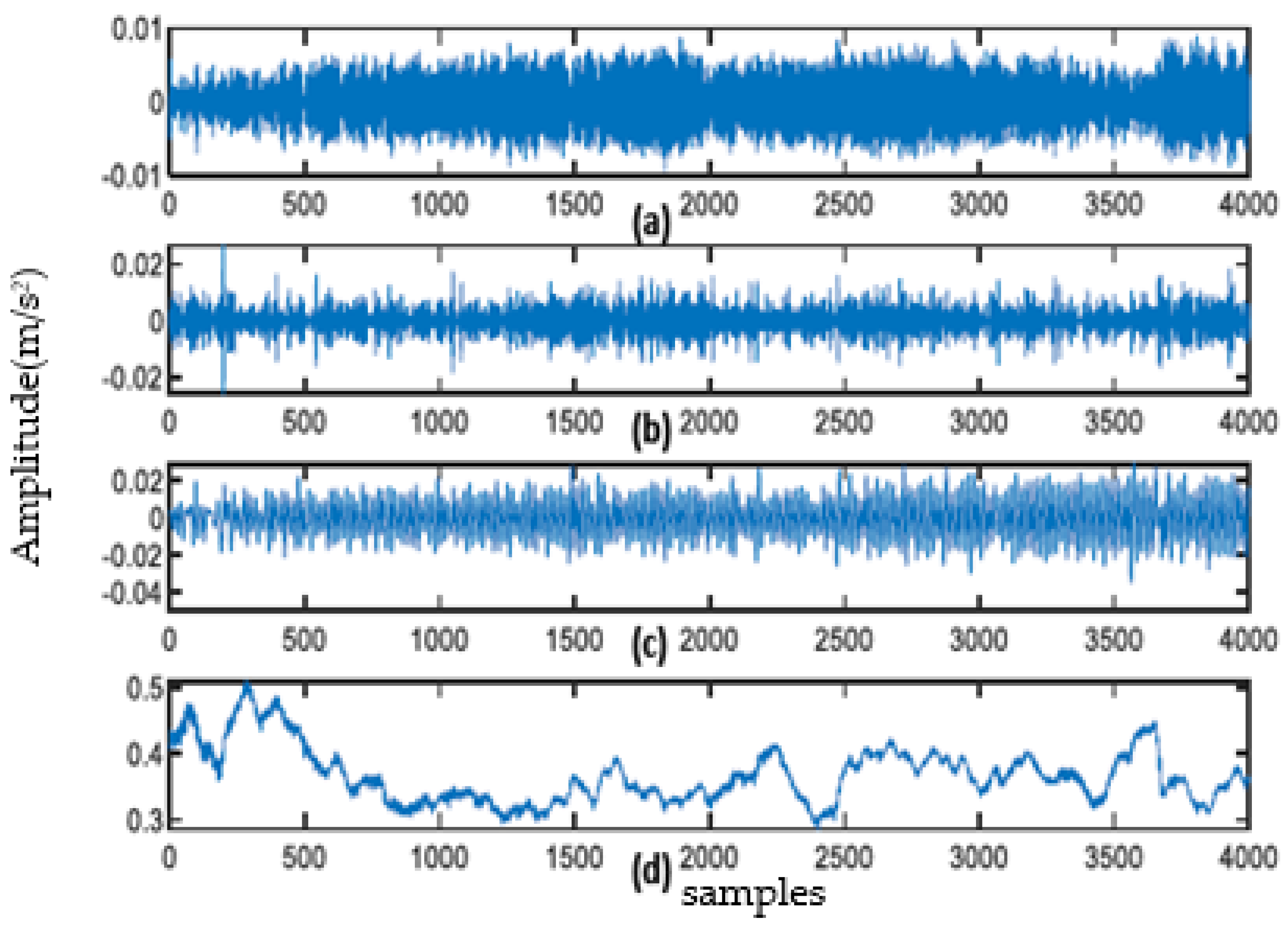


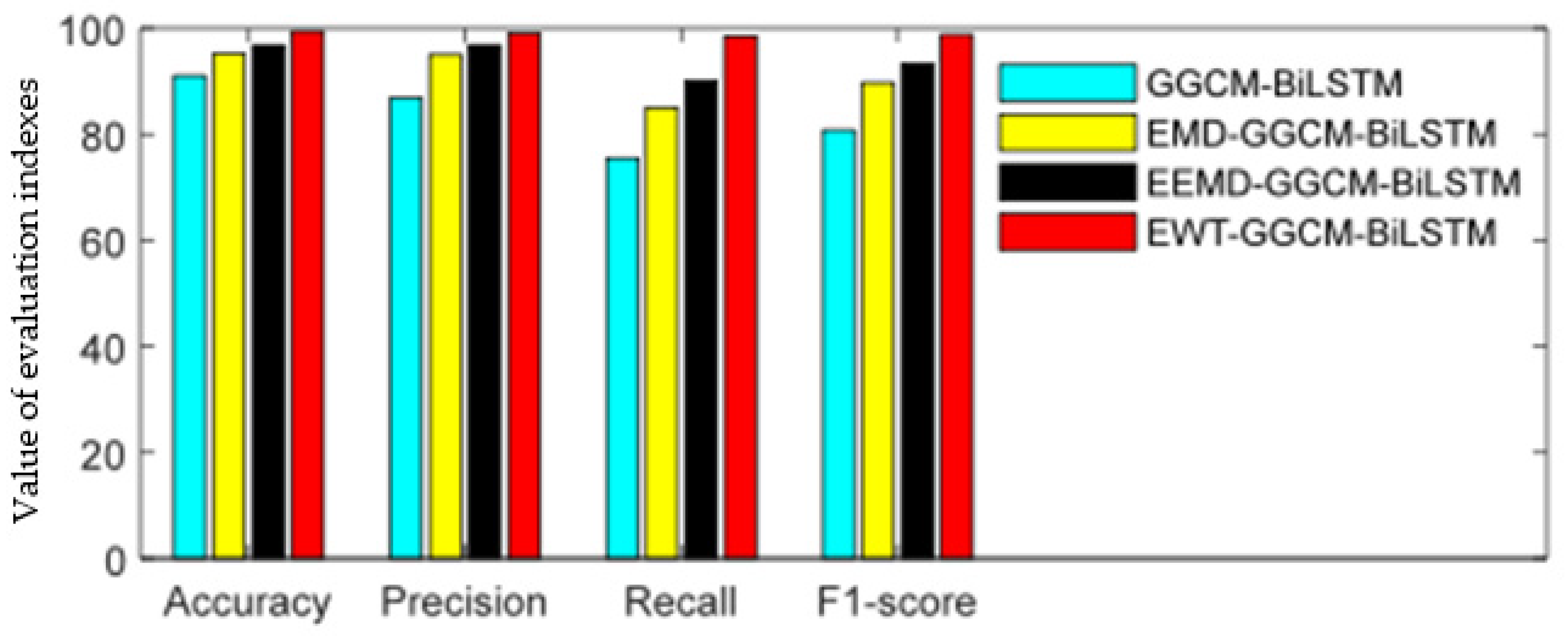
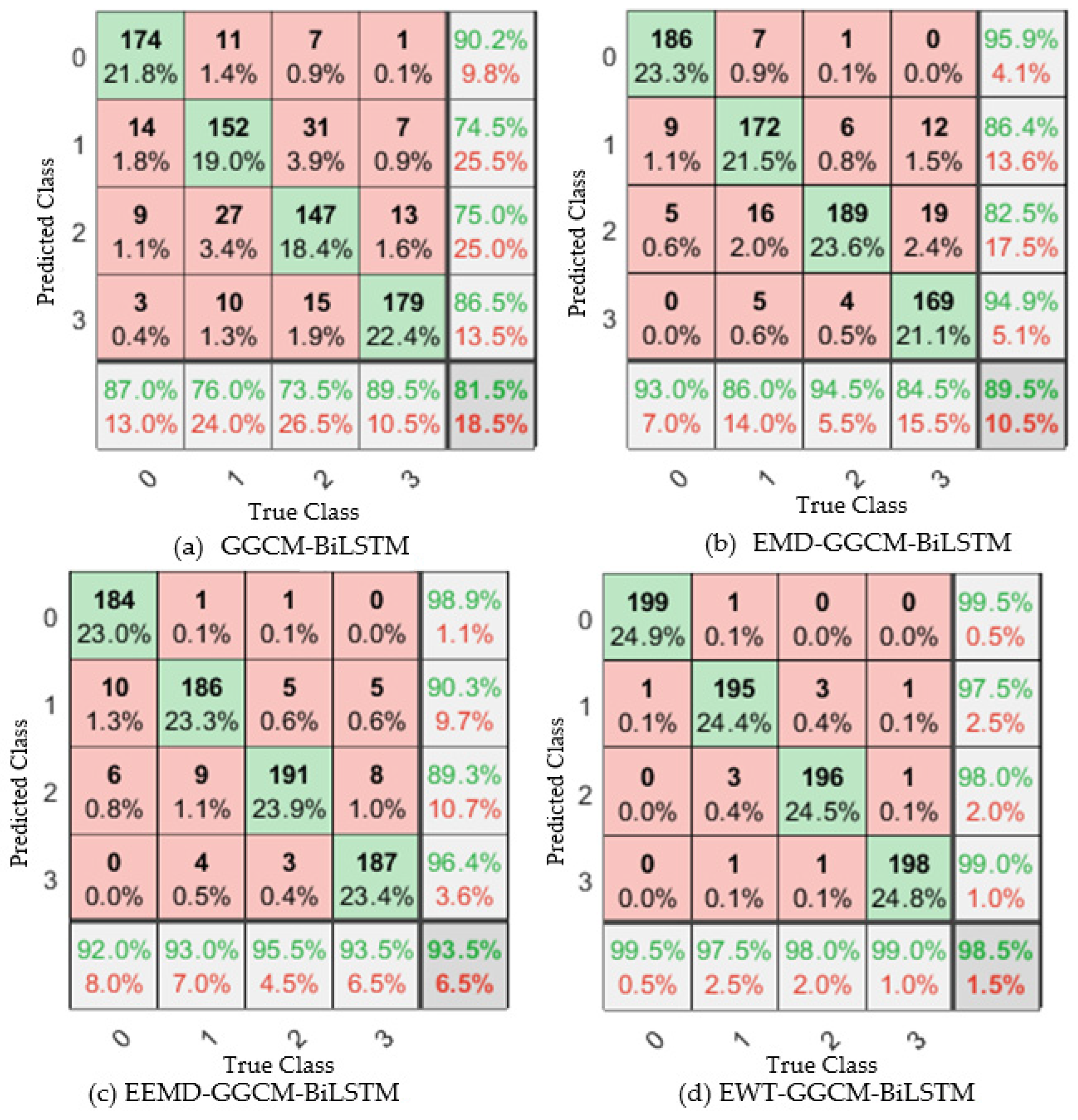


| Texture Features | T1 | T2 | T3 | T4 | T5 | T6 | |
|---|---|---|---|---|---|---|---|
| Normal state | EMF2 | 0.9300 | 0.5323 | 0.5475 | 0.5877 | 0.6980 | 0.8543 |
| EMF3 | 0.8131 | 0.4646 | 0.7053 | 0.5132 | 0.6135 | 0.8037 | |
| EMF4 | 0.9544 | 0.6359 | 0.5411 | 0.4140 | 0.5492 | 0.6752 | |
| Loosing 1 circle | EMF2 | 0.8342 | 0.6451 | 0.6937 | 0.7673 | 0.7835 | 0.9084 |
| EMF3 | 0.9290 | 0.6900 | 0.9012 | 0.6945 | 0.7202 | 0.8586 | |
| EMF4 | 0.8431 | 0.7770 | 0.6888 | 0.5236 | 0.6049 | 0.7110 | |
| Loosing 2 circle | EMF2 | 0.7490 | 0.4819 | 0.7825 | 0.8571 | 0.8846 | 0.9513 |
| EMF3 | 0.9411 | 0.6189 | 0.9459 | 0.7716 | 0.8318 | 0.8853 | |
| EMF4 | 0.7919 | 0.7212 | 0.7333 | 0.7143 | 0.7392 | 0.7728 | |
| Loosing 3 circles | EMF2 | 0.6391 | 0.7210 | 0.8546 | 0.9091 | 0.9160 | 0.9736 |
| EMF3 | 0.7510 | 0.7323 | 0.9826 | 0.8553 | 0.8826 | 0.9012 | |
| EMF4 | 0.6964 | 0.8730 | 0.8768 | 0.7791 | 0.7956 | 0.7922 | |
| Models | Accuracy (%) | Precision (%) | Recall (%) | F1 Score (%) |
|---|---|---|---|---|
| GGCM-BiLSTM | 91.00 | 86.78 | 75.50 | 80.75 |
| EMD-GGCM-BiLSTM | 95.13 | 94.97 | 85.00 | 89.71 |
| EEMD-GGCM-BiLSTM | 96.75 | 96.37 | 90.00 | 93.26 |
| EWT-GGCM-BiLSTM | 99.38 | 98.99 | 98.50 | 98.75 |
| Models | Accuracy (%) | Precision (%) | Recall (%) | F1-Score (%) |
|---|---|---|---|---|
| EWT-GGCM-NBC | 95.63 | 91.88 | 90.50 | 91.18 |
| EWT-GGCM-RF | 97.00 | 95.83 | 92.00 | 93.88 |
| EWT-GGCM-SVM | 97.87 | 96.45 | 95.00 | 95.72 |
| EWT-GGCM-BiLSTM | 99.38 | 98.99 | 98.50 | 98.75 |
Disclaimer/Publisher’s Note: The statements, opinions and data contained in all publications are solely those of the individual author(s) and contributor(s) and not of MDPI and/or the editor(s). MDPI and/or the editor(s) disclaim responsibility for any injury to people or property resulting from any ideas, methods, instructions or products referred to in the content. |
© 2023 by the authors. Licensee MDPI, Basel, Switzerland. This article is an open access article distributed under the terms and conditions of the Creative Commons Attribution (CC BY) license (https://creativecommons.org/licenses/by/4.0/).
Share and Cite
E, X.; Wang, W. Escalator Foundation Bolt Loosening Fault Recognition Based on Empirical Wavelet Transform and Multi-Scale Gray-Gradient Co-Occurrence Matrix. Sensors 2023, 23, 6801. https://doi.org/10.3390/s23156801
E X, Wang W. Escalator Foundation Bolt Loosening Fault Recognition Based on Empirical Wavelet Transform and Multi-Scale Gray-Gradient Co-Occurrence Matrix. Sensors. 2023; 23(15):6801. https://doi.org/10.3390/s23156801
Chicago/Turabian StyleE, Xuezhuang, and Wenbo Wang. 2023. "Escalator Foundation Bolt Loosening Fault Recognition Based on Empirical Wavelet Transform and Multi-Scale Gray-Gradient Co-Occurrence Matrix" Sensors 23, no. 15: 6801. https://doi.org/10.3390/s23156801
APA StyleE, X., & Wang, W. (2023). Escalator Foundation Bolt Loosening Fault Recognition Based on Empirical Wavelet Transform and Multi-Scale Gray-Gradient Co-Occurrence Matrix. Sensors, 23(15), 6801. https://doi.org/10.3390/s23156801






